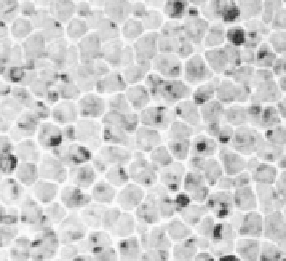Information Technology Reference
In-Depth Information
6.2.4.2. Superparamagnetic Limit.
For the first time since the inception of
the data storage, the traditional technology cannot be improved further. The
reason is the superparamagnetic limit [16]. This fundamental limit is caused by
thermal instabilities in the recording media when physical bit dimensions are
reduced below certain fundamental values. Each bit in the recording media
consists of over 100 grains. Though the grains are magnetostatically coupled,
the separation between adjacent grains is large enough (
1 nm) to ensure the
grains are ''exchange'' decoupled. The ''exchange'' coupling is a quantum mecha-
nical coupling that exists at a separation of less than approximately a few
nanometers [17]. In this case and, to some degree of approximation, the law of
large number would prevail if the number of grains is maintained approximately
greater than 100 [18, 19]. In other words, to maintain a certain value for the signal-
to-noise ratio (SNR), e.g., 20 dB, in a recording system, it is important to have the
number of grains be greater than approximately 100. Therefore, when with each
next generation bit dimensions are reduced, each grain dimension also must be
reduced to maintain the number of grains and thus SNR value required for
adequate signal processing. A transmission electron microscopy (TEM) image of a
patch of a longitudinal recording media suitable for areal densities above
100Gbit/in
2
is shown in Figure 6.3a [20, 21]. The characteristic diameter of an
average grain is approximately 6 nm. Figure 6.3b shows a schematic illustrating
how a transition between two adjacent bits would be written. Now, according to
the scaling law, to further increase areal density by a factor of four, i.e., up to
400Gbit/in
2
, the characteristic diameter of an average grain should be reduced by
a factor of two, i.e., it should be reduced to 3 nm. Unfortunately, here also lies a
problem.
The problem is the superparamagnetic limit. As the grain size is reduced (with
each generation), the anisotropy energy, equal to the product of the grain volume
B
TEM
Magnetic
grains
Bit transition
(a)
(b)
Figure
6.3.
(a) A transmission electron microscopy (TEM) image of a micropatch
of a typical CoCr-based longitudinal magnetic recording media. (b) A schematic
illustrating how a transition between two adjacent bits of information is defined
by the granular structure of the recording media.

























































Search WWH ::

Custom Search